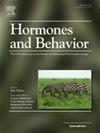Birth controlling your fears: The long-term effects of adolescent exposure to hormonal contraceptives on fear extinction in long-evans female rats
IF 2.4
3区 医学
Q2 BEHAVIORAL SCIENCES
引用次数: 0
Abstract
The mechanisms involved in inhibiting fear to a threatening cue can be studied in the laboratory via fear extinction, which is a process thought to underpin the development and treatment of anxiety disorders. In adult female rats, fluctuating sex hormones across the estrous cycle modulate fear extinction, and suppressing sex hormones via hormonal contraceptives (HCs) impairs fear extinction. Despite high usage of HCs during adolescence, no research has examined HC effects on extinction during this developmental phase. In the current study, adolescent female rats (postnatal day 35) were administered a nine day treatment of one of two HC formulations: a high dose of levonorgestrel (LEV), or a lower dose of LEV combined with ethinyl estradiol (EE). Rats received fear conditioning, extinction training, and extinction retention, either across the last few days of HC exposure, or two weeks post HC-cessation as adults (postnatal day 58). In both adolescents and adults, LEV impaired extinction retention, but EE + LEV did not. Altogether, these findings provide evidence that LEV impairs extinction retention during adolescence, and that this impairing effect lasts beyond the cessation of LEV when exposure begins during adolescence. Both HC formulations suppressed endogenous sex hormones during HC exposure, and neither produced long-term effects on endogenous sex hormones two weeks post cessation, suggesting that suppression of endogenous hormones were not the sole mechanism for the impairing effects of LEV on extinction retention. Such findings may have implications for the potential impact of HC use during adolescence on the development and treatment of anxiety disorders.
生育控制你的恐惧:在long-evans雌性大鼠中,青春期接触激素避孕药对恐惧消退的长期影响
抑制对威胁线索的恐惧的机制可以通过恐惧消退在实验室中进行研究,这一过程被认为是焦虑症发展和治疗的基础。在成年雌性大鼠中,在发情周期中波动的性激素调节恐惧消退,而通过激素避孕药(HCs)抑制性激素会损害恐惧消退。尽管青少年时期HC的使用率很高,但没有研究调查过在这一发育阶段HC对灭绝的影响。在目前的研究中,青春期雌性大鼠(出生后第35天)接受为期9天的两种HC制剂中的一种治疗:高剂量的左炔诺孕酮(LEV),或低剂量的LEV与乙炔雌二醇(EE)联合。大鼠在HC暴露的最后几天或成年后HC停止后两周(出生后第58天)接受恐惧条件反射、消失训练和消失保留。在青少年和成人中,LEV都损害了消失保留,但EE + LEV没有。总之,这些发现提供了证据,表明LEV损害了青春期的消退保留,并且这种损害效应持续到青春期开始接触LEV时停止后。两种HC配方在HC暴露期间均抑制内源性性激素,并且在停止后两周均未对内源性性激素产生长期影响,这表明抑制内源性性激素并不是LEV损害灭绝保留作用的唯一机制。这些发现可能暗示了青少年时期使用HC对焦虑症的发展和治疗的潜在影响。
本文章由计算机程序翻译,如有差异,请以英文原文为准。
求助全文
约1分钟内获得全文
求助全文
来源期刊

Hormones and Behavior
医学-行为科学
CiteScore
6.70
自引率
8.60%
发文量
139
审稿时长
91 days
期刊介绍:
Hormones and Behavior publishes original research articles, reviews and special issues concerning hormone-brain-behavior relationships, broadly defined. The journal''s scope ranges from laboratory and field studies concerning neuroendocrine as well as endocrine mechanisms controlling the development or adult expression of behavior to studies concerning the environmental control and evolutionary significance of hormone-behavior relationships. The journal welcomes studies conducted on species ranging from invertebrates to mammals, including humans.
 求助内容:
求助内容: 应助结果提醒方式:
应助结果提醒方式:


